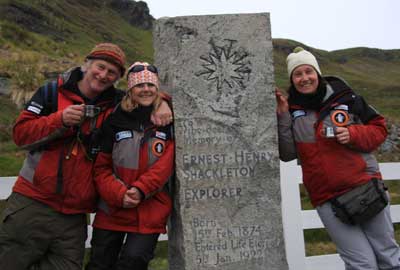From their hiding places in hummocky tussocks of grass, Antarctic fur seals of all shapes and sizes lunge towards us – snapping and barking – as we climb the well-trodden path to the memorial cairn and cross erected to Sir Ernest Shackleton in Grytviken, South Georgia. In the lead is Jonathan Shackleton, an Irish organic farmer, author, and cousin to Sir Ernest, the great Antarctic explorer.
Grytviken, an abandoned Norwegian whaling station littered with whale vertebrae and rusting rendering tanks, is populated today by 13 Britons and countless king penguins, fur seals, and elephant seals.
Stuffed inside the stone cairn is a scroll containing a photo and signatures from the crew of Shackleton’s Quest Expedition of 1921-22. With great reverence and an historical sense of place, Jonathan reads out the crew’s names to our group of modern-day explorers who has travelled to Antarctica and South Georgia, following in Shackleton’s footsteps one hundred years later.
Numbered amongst the Quest’s crew is George Vibert Douglas, a Canadian and professor of geology at Dalhousie University from 1932 to 1957. Dr. Douglas erected the stone cairn and white cross on a rocky headland at the entrance to Grytviken Harbour, shortly after Shackleton’s death here in 1922. Chief of the Quest’s scientific crew, he ensured that the cross faced the Magnetic South Pole which was discovered during Shackleton’s 1909 Nimrod Expedition.
Dr. Douglas processed the geological samples collected during the Quest Expedition at Harvard University. When he assumed the first Carnegie Professorship of Geology at Dalhousie in 1933, Dr. Douglas was paid a handsome sum for those days: $4,500 per annum.
A Dalhousie alumna and geologist, I jumped at the once-in-a-lifetime opportunity to participate in the 2010 Elysium Epic Visual Expedition, as one of its 57 explorers from 19 nations.
For 19 days in February and March 2010, the Elysium Team journeyed to the bottom of the world, and documented the impacts of accelerating climate change – both above and below the water – on the planet’s last remaining frontier. We retraced Shackleton’s Imperial Trans-Antarctic Imperial Expedition of 1914-17, a journey that went horribly sideways when the Endurance was crushed by ice and sank, precipitating one of the greatest survival stories in modern history.
As a member of Elysium’s scientific crew, I worked with the world’s preeminent scientists, scuba divers, movie makers, photographers, artists, and explorers, including National Geographic’s Emory Kristof who co-discovered the Titanic. Kristof wants to find the Endurance which sits in 10,000 feet of water.
 |
| Susan Eaton, second from the left, at the stone cairn erected by George Vibert Douglas, a professor of geology at Dalhousie from 1932 to 1957. (Photo courtesy of Susan Eaton) |
Underwater exploration in Antarctica is cold and challenging on all fronts: I snorkelled with curious leopard seals who played hide-and-seek around ice bergs. Fierce predators, leopard seals’ heads dwarf those of grizzly bears, and, as they approached – with mouths wide open in threat displays – I could count the freckles on their tongues and upper palates.
Shackleton’s polar expeditions always included geologists and geophysicists – during the audition for a spot in Expedition, I pitched my vision of recreating the role of the ship’s geoscientist 100 years later, providing an unique perspective to the discussions of climate change, glaciology, and oceanography. My vision was supported by numerous corporate and scientific sponsors, and by generous individual donors.
Over cocktails one evening, I discovered another Dalhousie connection with just one degree separation: Dr. Stephen Nicol, the expedition’s krill expert from the Australian Antarctic Division, received his doctorate from Dalhousie in 1984. In fact, we discovered that we had studied with some of the same marine biology professors, and speculated about whether Dr. Nicol had been one of my lab tutors.
During our return voyage to South America, force 11 seas with 15-metre-high waves and 65-knot-per-hour winds kept us confined below decks for several days, earning us the title of ‘sea wolves’ from the Russian captain and crew. The view from the ship’s bridge on the seventh storey was terrifying, especially at night, and was akin to driving through a car wash.
Participation in the Elysium Expedition represented the biggest logistical undertaking of my life to date, and it marked the confluence of my many divergent career and life pathways – geology, biology, geophysics, journalism, environmental advocacy, and scuba diving – which flowed together seamlessly amidst the backdrop of the harshest climate on Earth.

